#phase-specific estimates
Explore tagged Tumblr posts
Text
Managing Complexity | How a Construction Estimating Service Handles Multi-Phase Projects
Introduction Multi-phase construction projects—whether for residential communities, commercial developments, or infrastructure builds—present a unique set of challenges. These projects require meticulous coordination across timelines, trades, and budgetary constraints. A construction estimating service becomes an indispensable asset in managing this complexity. By breaking the project into defined phases and applying structured estimating techniques, estimators help ensure clarity, efficiency, and financial control from planning through execution.
Understanding Multi-Phase Projects Multi-phase projects involve construction that unfolds in sequential or overlapping stages. Each phase might have its own design, scope, permitting requirements, and budget. Without careful cost planning, projects can suffer from cost overruns, resource misallocations, and scheduling conflicts. A construction estimating service mitigates these risks by producing phase-specific estimates that contribute to an accurate overall cost forecast.
Phase-Based Budgeting and Cash Flow Planning One of the primary contributions of a construction estimating service in multi-phase projects is segmented budgeting. Estimators prepare separate budgets for each project phase, allowing stakeholders to manage cash flow more effectively. This approach ensures that funding aligns with the project schedule and avoids unnecessary capital tie-ups in early phases.
Improved Forecasting with Historical Data and Cost Indices Construction estimating services often use historical data from similar projects to inform pricing for each phase. They also adjust for anticipated material and labor price fluctuations using industry cost indices. These forecasting tools are especially useful for long-term, multi-year projects where inflation or market volatility can have a significant financial impact.
Trade Coordination Across Phases Different phases may involve different trades or subcontractors, and proper sequencing is crucial. A construction estimating service helps coordinate trade involvement across phases, accounting for their availability, costs, and project dependencies. This avoids delays caused by poor scheduling or miscommunication between contractors.
Scope Definition and Scope Control In multi-phase projects, the scope of work for later phases often evolves as earlier stages are completed. A construction estimating service provides detailed documentation and clear scope definitions for each phase, reducing the likelihood of scope creep. Estimators also flag areas where cost contingencies may be needed, ensuring flexibility without compromising financial oversight.
Phase-Specific Risk Assessments Each phase of a project carries distinct risks—such as weather impacts during specific seasons, regulatory delays, or equipment mobilization needs. A skilled estimator evaluates these risks and integrates them into the phase-specific cost models. This proactive approach allows contractors and owners to make informed decisions and reduce the likelihood of expensive surprises.
Technology Integration for Phase Tracking Modern construction estimating services utilize software that integrates estimating with project scheduling and management tools. This digital coordination enables real-time updates to budgets and forecasts as each phase progresses. Estimators can adjust estimates dynamically to reflect on-site conditions, scope changes, or updated client requirements.
Logistical Planning and Resource Optimization Multi-phase projects often require shared use of materials, labor, or equipment across different stages. Estimators help identify opportunities for resource optimization—for instance, bulk material purchases or long-term labor contracts that span multiple phases. This helps in controlling costs and reducing waste.
Inter-Phase Communication and Stakeholder Alignment Construction estimating services contribute to better communication between architects, engineers, contractors, and clients. They provide a financial roadmap for each phase that aligns everyone on the expected costs, deliverables, and timelines. This alignment minimizes rework, confusion, and last-minute budget adjustments.
Contingency Planning and Change Management In multi-phase projects, changes are inevitable. A construction estimating service builds in appropriate contingencies based on the complexity and uncertainty of each phase. Estimators also assist in pricing change orders accurately and swiftly, ensuring minimal disruption to both schedule and budget.
Regulatory and Permit Considerations by Phase Each phase may require separate regulatory approvals or permits. Estimators factor in the time and cost associated with these processes, including fees, consultant costs, and compliance-related expenses. This level of detail is crucial to avoid delays or cost escalations due to overlooked requirements.
Comprehensive Reporting for Long-Term Planning A professional construction estimating service provides consistent reporting and updates for each project phase. These reports offer insights on current costs, projected spending, and budget performance. They also help in adjusting long-term plans to align with real-time data, especially in projects lasting several years.
Conclusion Managing multi-phase projects is no easy task, but with a construction estimating service, it becomes significantly more feasible. These professionals bring structure to complex timelines, improve forecasting accuracy, and ensure financial discipline from start to finish. Whether it's a four-phase residential build or a multi-tower commercial complex, the role of an estimator is central to success, allowing project teams to move forward with confidence, clarity, and cost control.
#construction estimating service#multi-phase construction project#construction phase budgeting#estimating complex builds#phase-specific estimates#construction cost control#construction project segmentation#contractor phase coordination#construction forecasting#trade scheduling#phase-by-phase construction planning#phased development cost#estimating service benefits#construction financial planning#scope management#estimating risk analysis#resource allocation in construction#construction estimating technology#cost estimating software#managing construction inflation#construction project communication#estimating for large projects#construction budget breakdown#cash flow planning construction#contingency cost estimating#multi-phase estimating strategy#estimating permit costs#phase coordination tools#project lifecycle estimating#estimating service accuracy
0 notes
Text
Since I've been getting a few more asks about Episode 3—no I'm not hiding it from anyone, no it's not going to be released for the public any time soon, and yes, it is being worked on, and yes it is getting closer to being finished!
The majority of it is available to play as an alpha demo on my Patreon, although what currently playable is locked to specific Episode 2 endings.
My quarterly roadmaps are posted both here and on itch.io, and have all the updates about what's going on with Episode 3 and where I am currently am in development (Q1 report is here, Q2 report here!).
Episode 3 is the finale of Act 1. There are a lot of choices, a lot of decisions that will impact the future of your playthrough and your Wayfarer's journey. Many of your decisions from Episode 2 will come back to haunt you (in a good way or a bad way) in Episode 3. This episode is going to change everything, and the game and your Wayfarer will not be the same afterwards.
Finally, Episode 3 is the length of a full IF game due to its complexity. There is a reason why it is taking so long to develop. I know folks are impatient for more, but Wayfarer's episode structure is more like installments in a long-running series than chapters of a book. It takes time to pull off something like this, and I promise it will be worth the wait!

Green parts are playable and in the alpha build; blue is completed but not coded (and therefore are not in the alpha); yellow is in the drafting process; red is not started. word count is cumulative for all variations/routes/paths; single playthroughs will vary greatly in length depending on choices made.
I am very close to the end now, but it is very difficult to accurately estimate how long it will take me to finish. I know some people are angry about this, I know some people are disappointed and frustrated because the game is in-development and not a finished product. I know some people think I died and fell off the map or abandoned the project because it hasn't had a public update in a very long time (I didn't, I've always been here, working away).
I don't like releasing content before it's ready. I also don't like releasing episodes in bite-sized pieces even if it means more regular updates. I don't think that would make the game very enjoyable, and it also would make it buggier, with more time spent fixing stuff that I would have normally caught in the editing phase if I finished more things before coding.
I am well aware that Wayfarer is extremely ambitious in its scale, and I am going to live up to how ambitious it is. Ambition takes time, and also sometimes life hits hard. When you're a solo developer, no one else can pick up the slack if you get sick or have a family crisis or need to take time off, so you are going to perpetually be behind schedule.
(And no, other episodes are not going to be as long or as complicated as Episode 3!)
So, at this point I can't say when Episode 3 is being released. Only that it will be!
138 notes
·
View notes
Text
Sincere suggestions for commissioned artists, from a client's perspective
I am an artist myself, but I don't do commissions.
However I do commission artists and pay them $1000s of dollars USD every year! My project Transformers: Mercy has included around 100 artists and I look for new ones all the time on Tumblr. After all, I just couldn't complete my project without some help. In the Transformers fandom, I guess I could be a top fan artist employer! Screw AI art, right?!
(Feel free to DM me if you would like to be commissioned by me or volunteer art for my big Transformers: Prime sequel game.)
When everything goes well, I am a repeat commissioner and you have me as a permanent client. But what might turn me or another client away from commissioning you initially or a second time?
If you...
... Ask for email-only communication/ have any barriers to direct and fast communication [X]
If we're on Tumblr, I would just like to message you all the details for my comm and get quick updates here. Emailing is not swift! Or sometimes, you have a setting where only blogs you follow can message you. I'll try to leave a comment or an ask, but I might not be seen and the opportunity passes. Consider turning DMs on if you are looking for commissions!
I am also not a huge fan of downloading a comm question sheet, filling it out, and sending it back. It is so much faster for me to just dump all the details of my request (and by now, I know how to be specific). If anything is unclear, I would like the artist to just reach out and ask.
2. ... Give no regular communication and updates [X]
If someone has paid you for a service, please respect that. Give an estimated time for completion and if something comes up, update the client. Clients get nervous waiting days or weeks without updates and they should not have to reach out to ask about what they paid for. Give progress updates too... sketch phase, line art, flats, rendering, what have you. If the client wants changes, it is less grief for everyone to make the change before too much effort goes into the comm. Please, reassure your clients!
3. ... Don't refer to given instructions and reference pictures [X]
I give very specific instructions and reference pictures for my artists. Sometimes, time passes. They forget what the instructions were and send me a work in progress that is not what was requested. It's frustrating when with a scroll up, they would have seen all the instructions again. Please look back to your instructions constantly throughout the process, not just once. Double-check for details as you work.
Client story: Sometimes it's as silly as me asking for a night scene and getting sent a day scene. Sometimes it's characters doing the wrong action. Sometimes it's the wrong angle from what I asked for. Sometimes it's forgetting that I wanted a character to be holding a certain item. All the instructions were given, and the chunk of text which describes the scene, but they were not carefully read.
4. ... State "no changes" or "limited number of changes" in your comm sheet [X]
This worries a client like me. What does that mean, I wonder? What if I perfectly expressed my request but the artist didn't get it right? Will they get upset if I request a small change? I have come to understand some people mean "no major changes from the original request", but it can sound like I don't have a say in the production phase and I could be stuck with something I don't like.
Client story: One time, an artist forgot a piece to a character's arm. It was a wing and blaster, clear on the reference sheet. I only noticed later after the comm was done, so that was on me. I reached out, hoping they could add in the missing piece even for a reasonable quick price because it took me so long to notice. They told me it would cost $40 USD to add in the piece of the arm. I declined. $40 USD, for a piece of an arm?? It was unreasonable. Because of that, I have not returned to this client and otherwise would have.
5. ... Ask for payment up front [X?]
It's a stand off! Because no one wants to be scammed. The artist is afraid of spending so much time and effort to not be paid; the client is afraid the artist is a fraud and will run away with the money.
Now I haven't been scammed yet and I have paid many artists up front many times. But I saw their blogs and they seem trustworthy. Whereas those bots on fanfiction.net, never trust them. But it is still uncomfortable as a client to pay upfront. Sometimes I pay an artist, then 6 months later, I get my art. If you need a lot of time to finish a piece, inform the client and consider getting your payment after. Care for your client and ease their worries. It isn't fun to pay someone then get radio silence for a quarter or half a year... imagine being in that position!
The best solution I've seen? The client pays full or half the payment after the rough sketch phase. The artist hasn't committed too much time yet and the client can see if the artist is capable or not of completing the request. I think it makes us all feel more at ease.
6. ... Are strict/inflexible with pricing [X]
An artist can decide their prices. This isn't about how to value art. But consider this story for nuance:
Client story: This artist I was working with, like most, had set prices per added character. However, I wanted some very tiny background characters who would be lower detail. Characters about the size of a pencil eraser. They wanted to charge full price for each character as though they were like those in detail in the foreground. We tried to negotiate a lower price, but I felt it was still ridiculously high for tiny background characters (around $25 each, if I recall). Because of this, I didn't return to this artist.
7. ... Want to be paid by the hour [X]
Look, I understand wanting to be paid minimum wage for your work. Art is a worthy job! Unfortunately, I have no way to monitor how many hours you actually worked on something. And what if you are slow on purpose? What if you personally are slow at art and not improving on your speed? I am not an employer at an animation studio or anything like that. This is too uncontrollable (and their estimated prices jump up to around $200+ USD for a scene that on average would otherwise cost me $50 USD). I think you should set your prices how you want then let people decide if that price suits them.
8. ... Want a signed contract [X]
Once again I understand not wanting to be scammed. I think the "pay upfront or pay after sketch" thing could protect you as an artist. Maybe you believe the contract comforts us both, but to me, it feels too suspicious or accusatory. No one wants to be treated as a scammer if they are sincere, right? It makes me too uncomfortable and the interaction too business-like. I prefer working with artists who are passionate about Transformers like me, which is why I only commission Transformers fan artists. That way we have real heart in the project. Let's not make it strictly about the money or a tight suspicious business interaction. If I see a contract to sign, I don't commission.
9. ... State "no posting or using the art" [X]
I commission art so that it can appear in my story game. If I pay an artist to make something that I can't show to others, it's a no go for me. I would like to reblog our commission or post it on social media while crediting the artist properly. Your clients are probably very excited to show their commissions (but the clients should never post the art without the credits and never sell that art for their own gain). I let my artists know what the art will be used for, but if I see a statement like this in a comm sheet, I don't reach out initially. It makes me think we'll have a conflict and aren't compatible.
10. ... Argue about how a scene or character should look [X]
This is an odd one, but here are two examples:
Client story: There were two characters in a scene. I asked if one of them could be smaller. The artist insisted they wanted the character to be larger (by this, I mean in height) because they liked big robots. I explained that this character wasn't particularly tall. For some reason, I had to push to get the character the height I wanted him for my story. It was unpleasant.
Client story: I like TFP Starscream without fangs. Some people like to add fangs. No biggie, until I'm the client paying you to draw him for me. They added fangs, I requested no fangs, it turned into an argument on why he should have fangs because he had jagged teeth in RID2015. Whatever it is, respect the client's preferences. Isn't the picture for them?
Please make your client happy and fulfill their requests.
11. ... Are rude or snappy! [X]
Client story: One time I reached out to an artist intending to do a huge commission. But I like to make the commission as fun as possible for my artists so I ask who their favourite Transformers characters are and if they prefer action or calm scenes. That way I can select a good scene for them off my giant list. And for this artist, I explained I had lots of options because it was a big story game. The artist demanded I just give my request, they said they just wanted to make money, then went on a rant that I was poorly organized. Well, we didn't do a commission and they missed out my $100 USD request.
Other suggestions to help you attract and retain clients:
Have someone proofread your comm sheet for typos and grammar (I have never turned someone down for this, it's just an idea)
Provide invoices that don't require addresses
Have a fun and positive comm sheet without passive aggressive statements. Do's and Don'ts are ok, but please don't seem bitter/fierce about something that may have happened in the past. Some terms and conditions really seemed to treat me like a troublemaker or threat!
Have a positive/non aggressive blog that avoids foul language
Appear open to discussion, flexible, and reasonable
These are just my suggestions: the suggestions of a client. It's up to you to accept or reject them as a paid artist. We all have our reasons. They are however, my secret reasons for not returning to certain artists or initially reaching out to them!
55 notes
·
View notes
Text
I was scrolling through instagram and came across that one scene of Kurapika repeatedly punching Chrollo while on route to make the trade off with the phantom troupe, a scene that though is not canon in the manga nor 2011 anime, is in hxh 1999. I went to the comments to see what others had to say on this addition, and was disheartened to find many fans unanimously coming to the agreement, especially because of this particular scene, that the main difference between Kurapika's characterization in 1999 vs. 2011 is that he's fundamentally "more childish" or "isn't able to keep his anger repressed as well"; rhetoric that I personally couldn’t disagree with more, respectfully.

I must say, they are correct about one thing though, in my opinion; Kurapika in the 1999 version is indeed characterized differently. All of the main four are. Its actually one of the main reasons why I prefer hxh 1999 despite not it not being fully accurate to cannon with the addition of several non-canonical scenes and dialogues. Such scenarios looked upon the original narrative given, estimated what would be the missing pieces in between in order to get to the current picture, and then used a combination of both the filler and original cannon to create characters who are consequently much more dynamic than their original counterparts. All the creators have done was really just set off on a proper set of chain of events in the plot to follow their development.
(In short, hxh 1999 is akin to a very well written, cannon compliant, fanficton with a very specific focus on character study through its additional scenes)
This is one of the many reasons why I find this scene particularly meaningful, as it serves as a direct expansion on Kurapika's characterization. Kurapika is the sort to scrutinize every action he makes based on his self imposed moral structure. We see this aspect of him made clear in the hunter exam, in which Leorio asks him if he's really willing to go to the depths it would take to become a blacklist hunter, knowing this fact about him just simply from the way he talked about hunters, and why, he found becoming a hunter just for the money, unjust. Kurapika, in response, assures him, that he will do anything, no matter if he deems it morally impermissible, if it meant to find and enact his revenge on the Spiders. However, when it came time to follow through with his statement, there is an inherent hesitation made or a flat out failure to act upon it. The very first instance of this is seen when it came time for him to kill the prisoner in trick tower so that he may advance past the third phase of the exam, resulting in a further advancement to his goal as quickly as possible.

He flat out refused to do so, despite it being the easiest most logical thing to do. The man was knocked out unconscious after all. And of course, Kurapika did state that he'd be willing to do anything. So then, why didn't he do it?
Because to him, killing in any circumstance is wrong. He creates a moral paradox for himself:
Cause of Revenge= morality->guilt-> duty
Execution of revenge= duty-> abandonment of morality-> guilt
And moreover, he is horribly self aware of this fact. He knows that discarding pieces of morality for the sake of his mission will fundamentally change him. His duty will never bring him peace and he knows it. In fact, it is the opposite, for he knows it will torment him relentlessly to the point in which he either breaks, or instead, he will become apathetic to it all. The later is the result he strives for though, as to follow through with his mission, he needs to be complicit in the face of evil.
But throughout the narrative, time and time again, it is evident that such moral sentiments never leave him. Sure, he works as a body guard for some of the most notorious criminals in the underworld, so rotten that Melody even goes as far to describe them as "devils", but fails to abandon his paradox. For Christ's sake, he even said in this particular version, that he found the sounds of pain Uvogin made while dying to be so abhorrent to the point, he couldn’t fathom how Uvo does it does it at; nonetheless without feeling any form of remorse. Kurapika loathes violence so greatly that he feels revolted in partaking in it, even if it is towards the person in which inflicted violence on him first. This displays that, to an extent, he held pity for Uvo, not in the sense that he regrets his actions but in the sense they had to be done at all, yet bares this sin for the sake of his brethren. But at the heart of it, especially since so little was gained for his overall mission, he falls to the gripping weight of his actions due to the breach of morality and it overtakes him for a brief moment.

But afterwards, he must carry on regardless if he likes it or not. He must continue up until the point in which he feels indifference to every morally abhorrent thing he has to do for the sake of his mission. Yet of course, he is not there yet, and because of this it only rightfully expected that his anger would boil over due to his moral turmoil, only for him to retreat in a sort of shame directly after doing so, realizing this part of the cycle he signed up for.
And this is why he rages at Chrollo. It's simply a part of this said cycle.
He punches him repeatedly, not only for the murder of his people, but the choices that he had to make as a result of the slaughter; that he was forced to create this paradox and resort to vengeful duty in which can only be fulfilled by measures of violence. The repeated punches, to me, are not done for the sake of incapacitation or for killing Chrollo (after all he couldn't have as that would mean that Gon and Killua's lives would be lost and it's apparent he'd never allow that) but as to give the biggest "fuck you for being so senselessly violent and cruel that in order for me to enact a properly weighted vengeance for my people that I must become just as senselessly violent, just as senselessly cruel, as you are."

Utilizing violence to mourn against the use of violence; this act is the pinnacle of it. A genius, visual representation of his profound moral conflict created for the audience. This is why this scene was so impactful. This is why this scene was needed.
#hunter x hunter#hxh#hxh 1999#kurapika#gon freecss#killua zoldyck#leorio paladiknight#chrollo lucilfer#phantom troupe#character analysis#long post
149 notes
·
View notes
Text
Global Emergency Compounded by the AIDS-like Features of SARS-CoV-2 Infection - Published Sept 1, 2024
Over a million people in the US are being infected with severe acute respiratory syndrome coronavirus type 2 (SARS-CoV-2) every day.
Originally named after the acute respiratory syndrome it can cause as a consequence of blood vessel damage in the lungs, SARS-CoV-2 is actually primarily a blood vessel virus that spreads through the airways. It causes a complex multisystem disease (1). It is airborne (2). It can persist in the body, and is detectable in body and brain tissue even at autopsy of “recovered” patients (3).
Each infection ages the body, causes damage to the blood vessels and the immune system, and affects organs including the heart, lungs, liver, kidneys, bones, etc. (4, 5, 6)
Each infection ages the brain. Specifically, it reduces gray matter and cognitive ability (7), and potentially IQ score (8). It increases the risk of psychiatric disorders (9). SARS-CoV-2 has also been identified as contributing to accelerated dementia (10).
The potential post-acute phase impacts of SARS-CoV-2 include long COVID, some manifestations of which are chronic conditions that can last a lifetime, including heart disease, diabetes, myalgic encephalomyelitis and dysautonomia (11).
The Economist has estimated excess deaths from the beginning of the Pandemic through May 2024 at up to 35 million people worldwide. (12)
In Addition, Many Scientists Are Now Issuing Warnings… SARS-CoV-2 triggers a new airborne form of Acquired Immune Deficiency Syndrome (13, 14, 15) (some are proposing specific terms such as “CoV-AIDS”).
This is not AIDS as we know it from human immunodeficiency virus (HIV) infection, it is a new type of acquired immunodeficiency syndrome with different deleterious effects on immune function (16, 17, 18, 19, 20, 21), but both resulting in increased vulnerability to infections (22). Immune system deficiency and other COVID properties also suggest a potential link to greater risk of cancers (23, 24, 25, 26, 27).
The “original” AIDS caused by HIV takes up to around 10 to 15 years to make its presence felt, with the initial infection usually barely noticed and often resembling the common cold or a flu-like disease until its damage manifests itself leading to death in the absence of treatments (28, 29).
With SARS-CoV-2, immunodeficiency develops in the weeks and months following infection. It involves reduction and functional exhaustion of T Cells (30), enhanced inhibition of MHC-I expression (31), downregulating CD19 expression in B cells (32) and other evidence of immune dysregulation (33, 34). In one study, the dysregulation persisted for 8 months following initial mild-to-moderate SARS-CoV-2 infection, the length of the study (35). There is no “cure” for any of the damage caused by SARS-CoV-2 including immune dysregulation.
Did You Know? Repeated infections are leading to prolonged immune dysregulation, and increase the risk of progressive disability and death.
Long COVID is a multisystem disease with debilitating symptoms, which has had a profound impact on society and the global economy. In the USA, economists have estimated that long COVID will incur cumulative future costs of more than US$4 trillion (36, 37).
The worldwide devastating economic consequences of this mass disabling event have been measured in terms of total work hours and GDP lost around the world (38).
It theoretically only takes a single viral particle to initiate an infection, and most infections are initiated by very few viral particles (39).
Despite current popular belief, the immune system is NOT a muscle, and does NOT benefit from being repeatedly challenged with disease-causing microbes. In fact, its finite resources are depleted with each new infection.
Herd immunity is unattainable for a rapidly mutating, immune-disrupting virus, and there is no basis to believe that a vascular infection will evolve into the common cold. Continuing to ignore SARS-CoV-2 will not make it go away. Depriving the virus of publicity does not deprive it of its continuing lethal effects.
SARS-CoV-2 is continuing to evolve and mutate – it is not running out of evolutionary space. It is not a cold or the flu, but primarily a blood vessel disease. It is damaging society as we know it.
How many repeated infections can we expect young people to endure and survive? Even if they get only 1 infection each year, that’s 10 infections in 10 school years. This is not compatible with health and a long life. Repeated infections can lead to long COVID and shortened lifespans.
How Do We Protect Ourselves, How Do We Protect Our Children, When Government Public Health Advice Has Failed?
By reducing transmission so that R0 remains less than one (meaning that each person infects less than one other), we can suppress and gradually eliminate the virus, targeting a safer return to pre-2020 normal.
Handwashing is helpful, but it is not the main way to stop the spread of this airborne virus.
Respirators can block 95% or more of virus particles through electrostatic action, and are therefore highly effective at reducing infection even if only one person in a conversation is wearing them. They are far more effective if all people are wearing them (40).
Transmission can be reduced with HEPA filtration and ventilation of indoor air.
The virus spreads more quickly in indoor settings, but also spreads outdoors.
For medical facilities, it is essential to clean the air with ventilation and filtration and require universal high-quality masking (with N-95/ FFP3 respirators or better) to protect medical staff and patients.
For workplaces, clean air will reduce transmission; and encouraging employees to test and stay home when infectious is essential. High-quality masking should be encouraged in the case of symptoms, a sick person at home, or any other suspicion that one could be carrying the virus. Remote work should be normalized and encouraged wherever possible.
For entertainment venues, events should be held outdoors when possible; and if indoors, clean air is key to protecting audiences. Audiences should also be encouraged to wear respirators to avoid getting infected and infecting others. Digital streaming options should always be offered.
For restaurants, an emphasis on outdoor dining will substantially reduce transmission. Patio service should be encouraged, and indoor dining areas should be well-ventilated with a high level of air-exchanges. Home or curbside delivery offers a safer alternative.
For schools, clean air will reduce transmission; encouraging students to test and stay home when infectious is essential to preserving their health. Masking or remote learning should be initiated whenever a case is detected or the incidence in the general population sharply increases. A permanent hybrid model / digital option can accommodate children with disabilities or those who simply do better learning from home.
Teachers and medical professionals may prefer to use transparent masks, or to wear HEPA-filtered headgear equipment that may be more universally tolerated/accepted.
To track our progress, we need sustained wastewater and population-level testing.
With just 60-70 percent of people taking mitigation measures such as masking, testing and isolating when infected, we can dramatically reduce forward transmission of the virus.
Even with very imperfect measures, as long as one infected person does not infect more than one person on average, the virus will eventually die out. The fewer people each person infects on average, the faster it will happen.
We still have a window of opportunity. Protecting ourselves and our families is in fact protecting the economy and the continued orderly functioning of our society.
#covid#mask up#pandemic#covid 19#wear a mask#coronavirus#sars cov 2#public health#still coviding#wear a respirator#long covid#AIDS
195 notes
·
View notes
Note
Centrally-unplanned, the discourser in me wants to make a certain dunk right now, but the prosocial human in me considers that it may be rude. It really depends on how you parse dunks, if they are a sort of "all part of the game" aspect of internet debate club for you, or if they come off as more personal. May I dunk on you (if I can even find the relevant post, it's quite old)?
Haha you can totally dunk on me, assuming it is respectful (as I am sure you would be). Like I might counter-dunk, and if Im not in the mood I may not reply, but that is not a big deal, earned dunks stand on their own.
But I also know what you are gonna say! You don't have to bring it up! I specifically remember debating with you about how the US was "post" its Middle Eastern Adventures phase, and that in the end Russia/China are bigger threats to the international order.
And I will only take a partial L here - I don't think "Israel dragging the US into supporting its own op that it is doing anyway - in defiance of US requests even - as part of wider regional war" is the same thing as the Iraq war or anything, it really isn't. Particularly when you have things like Germany tacitly endorsing Israel doing it! People on the internet struggle hard to grasp how "consensus" being pro-Israel & anti-Iran is; Israel has shed the former recently, but only very recently, and the latter is still strong. The entire point of that debate is how much overagency people assign to the US when regional conflicts are gonna rage regardless.
But I said partial L - it is an L. I was wrong. I thought the Trump administration was going to be really bad, and they have been, on every single axis, so much worse than I was expecting. It is comical how bad they are, just at everything. We are just straight-up gaslighting the CIA's own estimates to justify a muscle flex for clout. All of our institutions are not currently dead or anything, but under a far more sustained assault than they have ever experienced in the modern era. I try not to stress about it, but this time it is truly different.
38 notes
·
View notes
Text
A MISSING PIECE IN THE BIG BANG THEORY HAS SURFACED??
Blog#411
Wednesday, June 19th, 2024.
Welcome back,
Combining different pieces from Big Bang cosmology could help explain an issue we have today.
The Hubble constant, the speed of expansion of our universe, is not observed with consistency.
These scientists suggest that not-well-understood quantum gravity could account for the gap.

In research published earlier this year, physicists from the University of Hyderabad in India say they’re on the path to solving one of the universe’s biggest outstanding problems. Since Edwin Hubble realized the universe is always expanding nearly 100 years ago, scientists have used the “Hubble constant” in calculations on virtually every scale in the universe.
But today, estimates for the Hubble constant don’t always align, with a difference of up to 10 percent between calculations made using different methods. (When someone at NASA mixes up meters and yards and loses an entire spacecraft, that’s not even a full 10 percent deviation.)

The paper appears in the peer reviewed journal Classical and Quantum Gravity. The journal has an ongoing, periodically updated “focus issue” specifically about this measurement tension, and the editors explain the problem there—scientists can’t say for sure that the different Hubble constants measured are actually different, rather than just observation or calibration issues.
But the authors of the new paper, physicist P.K. Suresh and his research fellow (referred to as just Anupama B.) say that most measurements taken now are reliable. Instrumentation only continues to improve—we’ve all seen those generation-defining, poster-quality photos of the far-out planets, for example. If the measurements on the local and faraway levels are indeed sound, then something is missing.

It’s here where they introduce quantum gravity as a possible factor. This variable—which, to be honest, is another enigmatic “placeholder” in some ways—could close the gap in Hubble constant observations. That’s because, as the authors propose, quantum gravity could have affected the rate of change at which the universe expanded itself. When a constant can have a variable rate of change, it’s easy to see why researchers tend to drop the ‘constant’ label and instead call the fatcor simply H0, H1, and so on to designate which version of the measurement is in play.

The researchers explain that during inflation—the rapid growth of the universe immediately following the Big Bang—there may not have been a single, uniform inflation zone. Instead, more and more scientists are theorizing around the idea of “multi field” inflation. The idea originated to explain another measurement discrepancy: the number of particles in particular places or times, compared with the massive speed of inflation overall.

If a theory could help explain one gap in our codified equations for how inflation works, it makes sense to try that theory to find other missing pieces. These researchers used what is called the hybrid inflationary model, which describes two fields: one inflating and one rolling over like a waterfall. By accounting for quantum gravity, they found they were able to reconcile H0—the current Hubble constant—with both H1 (during inflation) and HT (during phase transition). Just one adjusted equation with a parameter for quantum gravity could draw a curve that includes all three data points.
Originally published on www.popularmechanics.com
COMING UP!!
(Saturday, June 22nd, 2024)
"WHAT IS THE OLDEST BLACK HOLE IN OUR UNIVERSE??"
#astronomy#outer space#alternate universe#astrophysics#universe#spacecraft#white universe#space#parallel universe#astrophotography
74 notes
·
View notes
Text


Draft Report [on Tuskegee Syphilis Study]
Record Group 442: Records of the Centers for Disease Control and PreventionSeries: Tuskegee Syphilis Study Administrative Records
-1- 10-8-49.
Alabama Untreated Syphilis Study
[handwritten] "Progression of Abnormalities over 16 yrs"? [/handwritten]
This paper is the fourth of a series of studies of untreated acquired syphilis in the male Negro in Macon County, Alabama. Previous papers [checkmark with "Ref" handwritten above] have health with ["^ (1)" handwritten] the [crossed out] extend of morbidity [/crossed out] ["various abnormalities found" handwritten above] in untreated syphilitics [crossed out] in comparison with [/crossed out] ["and" handwritten above] nonsyphilitic controls, ["at the time of the initial examination" handwritten above] the life expectancy of the respective groups ["after 10 yrs observation." handwritten to the right of the typewritten line] ["^ (2)" handwritten] the natural history of syphilis, uninfluenced by treatment, with special attention to [crossed out] its [/crossed out] ["the" handwritten above] effect ["^of the disease" handwritten above] on the cardiovascular system ["-after 5 yrs observation and" handwritten above]. The present study is a[crossed out "n"] ["^report made after 16 years observation and is an" handwritten above]attempt to estimate the ["- increment of abnormalities" handwritten below] [crossed out] progressive disability [/crossed out] among untreated syphilitics and nonsyphilitic controls ["-recurring during that 16 yr. period" handwritten below] [crossed out] during 16 years of observation. [/crossed out]
How are these different? [handwritten at right side with "HaK" circled below]
The original study population selected during ( the winter [crossed out] seasons [/crossed out] ["months" handwritten above] of) 1931-32 and 1932-33 consisted of 410 syphilitics and 201 ["^controls presumably" handwritten above] nonsyphilitic [crossed out] controls [/crossed out], all of [crossed out] which [/crossed out] ["whom ?" handwritten above] were 25 years of age or ["^older" handwritten above] [illegible text crossed out]. [crossed out] The individuals were carefully selected.[/crossed out] The presence or absence of syphilitic infection was based on personal history, physical examination, and serologic tests on the blood. [crossed out] Before the present far reaching aims of the study were actually set up, 179 [/crossed out] Of the syphilitic group ["^179" handwritten above] were given some treatment for their infection during the
What was the study pop. selected for??? [handwritten at the right with "HaK" circled below]
To be referenced a specific page in this paper. [handwritten at the right, signed "KHZ" below]-2-
period of this first examination. Most of these individuals were among the younger age groups, and were given amounts of treatment varying from 1 to 15 shots of neoarsephenamine. ["-These have been dropped from consideration in the present paper" handwritten above] A second complete physical examination was made of the majority of the group in 1938-39. [crossed out] However, no strenuous effort was made to locate those who received treatment, and consequently a large number of them lapsed from observation. [/crossed out] Since 1939, there has been an annual visit to Macon County by a physician for the purpose of obtaining specimens of blood for serologic examination. In the fall of 1948 a third physical examination was performed on the individuals who could be located at that time, [crossed out] again with no particular emphasis on those who had received some treatment. [/crossed out]
An important phase of the study has been the performance of autopsies on the individuals who have died. Through 1948, [crossed out] 163 [/crossed out] ["140" handwritten above] of the number included in the original population have died, and of these [crossed out] 111 [/crossed out] ["98" handwritten above] have been autopsied. Of those on whom [crossed out] have not been autopsied [/crossed out] ["autopsies have not been performed," handwritten above] proof of death has been established by death certificate or by information furnished by relatives or friends of the deceased. Because of the relatively non-migratory nature of the group, it is reasonably certain that there have been no other deaths than the [crossed out] 163 [/crossed out] ["140" handwritten above] recorded. No analysis of autopsy data will be attempted in this report; a detailed account of this
44 notes
·
View notes
Note
How long do you plan making rekindled? I loved Lo at some point, But now I cant get enough of your version!! And I wanted to know how did you come up with the darker back stories for Rekindled?
I have a semi-detailed skeleton of the plot with basically every story beat planned out, but I can't definitively say how long it will be as I haven't actually scripted every single episode out yet.
Not to mention a lot of the time my scripts will change from their original versions, by the time I get to an episode I've planned ahead for I've either thought of new ways to do it or don't like how it's paced so I change it. Case in point, there was a specific scene I had planned for the next episode and then wound up not liking the pacing because it was too fast so I moved it to several episodes away and restructured everything on the fly, took a whole new text document and scrapping sketches to figure shit out LOL I actually do have up until Episode 70ish scripted out in my documents with like, actual notes and dialogue for each episode, but I already have sooo many of those crossed out now because of how much I've had to tweak and change as time has gone on. This is why I plan ahead well in advance though, so that if I do need to make those changes, I can make them long before the episodes are even due to be drawn (and believe me, they get changed during the sketching phases too LOL).
What I can confirm for certain is that the current 'arc' we're in right now is definitely the bulk of the story. And that's not to say there isn't any content afterwards, more like the pacing just gets completely turned on its head in the last 30-40% of it where shit gets N U T S and just can't go back to the same energy that it was in the beginning. Without spoiling, there's a certain 'turning point' in the plot and everything after it isn't quite as long as the stint of story we're in now. This is mostly because the arc we're currently in is still establishing a bunch of stuff like the Underworld Corp, Persephone's schooling, etc. and once that turning point hits, it's basically all character development and focusing on the consequences of everything setup in the first arc.
I guess if I had to illustrate it, the story progression in the end will look something like this?
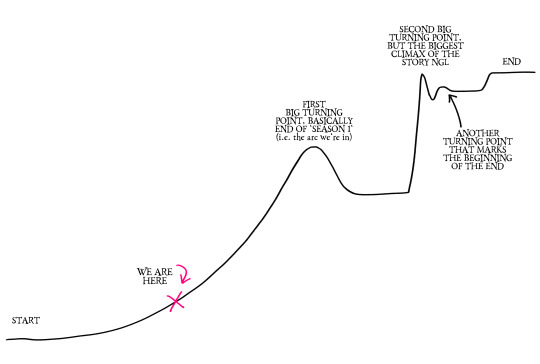
It's basically just this slow and chill climb that, once it hits that sharp peak, doesn't ever return to normal levels LMAO So I guess enjoy this part of the story while you can because it's the chillest it'll ever be w(°o°)w And boy, I am EXCITED for that peak, but we have a long way to go before we get there. As for how long, well, I'm hoping I'll be able to have Rekindled's story wrapped up in the next 2 years, tops. Just depends on how the update schedule goes, and assuming the plans I have put down for the plotting don't change in any major way. I don't have as much of the latter half of the story actually scripted out yet so for all I know it could wind up being way longer than anticipated, but right now I have a pretty good sense of how the story beats will play out in relation to each other.
So it's kind of a wait and see thing, at least until I have every episode scripted out, and even then I won't be 100% sure because things are always being tweaked and fixed and changed on the fly! I'm guessing it won't go much longer than 170 episodes, give or take, but that's a very very VERY rough estimate.
Regardless, Rekindled still has a lot more story to tell, and I'm hoping y'all enjoy the ride with me <3
As for the darker backstories, y'all don't even know yet. Like... I've got stuff planned. Stuff that even Banshriek (my BG assistant) doesn't know about. Stuff that I keep buried very deep in Rekindled's episode documents that won't see the light of day until they have to be ripped out of the deep dark trenches of the characters' own buried secrets, and by that point, the toothpaste will be out of the tube, there will be no going back. So, again... enjoy it while it lasts. Because I don't pull my punches. And maybe even you won't be able to look at me the same way again once the final blow has been dealt.
Sleep well.
:)
#k but i am actually really nervous for how those bigger turning points go#esp the spiky one LOL#i feel like it'll definitely be uh. interesting. in how people feel about it.#but mostly because it'll just be a punch to the gut#i will definitely give adequate warning when it's coming so that people can steel themselves LOL#ask me anything#ama#anon ama#anon ask me anything#lore rekindled ama
103 notes
·
View notes
Text
Since irredeamable wont release for some time. Ill be presenting some of my notable projects. I`ll start with the one i would most recommend. It's pretty old and janky but i think there is plenty to find for those willing to get past its flaws.
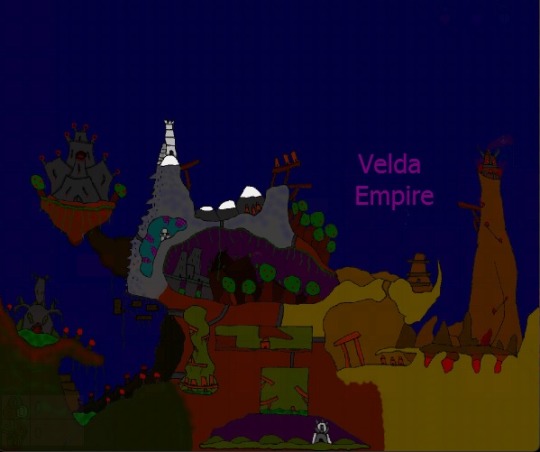
Black heart: Play it here and now!
One of my most Ambitious project ever, black heart is a sidescrolling action-adventure game, highly inspired by the zelda series. In it, you play as 3 sisters, going on a perilous journey to rescue their people from the tyrannical grasp of an evil empress.
Pros: -Each of the 3 sisters comes with a unique feel. From their attack pattern to their health, physics, and items. Much of the game is built around those distinctions. -The story is simple but effective, with a clear goal to achieve and many characters to meet. -The world is very expensive and diverse, containing several interconnected zones to discover and explore. -The lore is complex, nuanced, and intricate, each of the races is well-developed with their own history, culture, heroes, and villains. -The dungeons are large and numerous. Each features its own type of puzzle and distinct aesthetic. -The bosses are all unique and ambitious, often featuring several phases, mechanics, and attack patterns. -There are a whole lot of secrets to find, certain fun and silly, others strange or creepy.
Cons: -The main characters are pretty bland and display little personality outside of the few traits they are given. -Combat can be pretty bare-bone and uninteresting outside of boss fights -Some of the writing and lore have not aged well and could be considered a bit tasteless or insensitive. -Since puzzles are often built around specific characters which have their own hp, losing them can force players to backtrack.
Recommended to: -Fans of Zelda games who crave another game in the genre. -People who want to get lost in a big and complex world. -People who want to experience a fantasy world unlike any other. -People who long for a game that they can discover for themselves without risking being spoiled by walkthroughs or wikis.
Estimated Duration: 6-8 hours.
#solodev#game development#indiegamedev#indiedev#game design#fantasy#fantasy world#indie games#free game#zelda#metroidvania#platformer
99 notes
·
View notes
Text
I'm currently working on trying to find locations for some of the known rooms and things inside Alfea, (at the moment specifically, I'm working on the kitchen and dining hall) before I put myself through floor plans again. So I thought I'd share what some of my working out looks like behind the scenes.
And why it might be a problem that Season 8 turned these flat topped towers:

Into these much shorter flat topped towers:
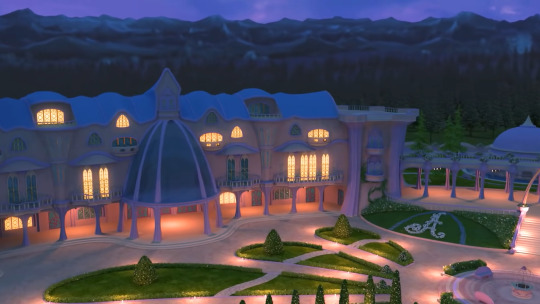
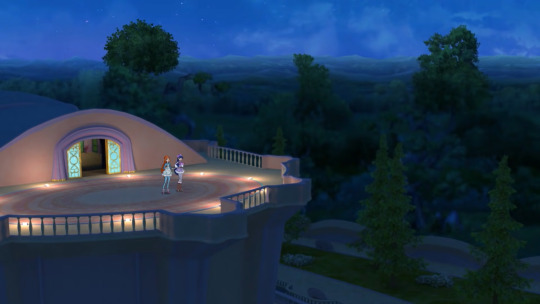
Because I'm currently fairly certain that was the dining hall in that upper half.
Trying to figure out where the dining hall is, isn't a one room tracking operation, because we know there's a kitchen, we've seen it, we've seen the Winx Club set fire to it with their negligence. You don't typically put a food making place far from the eating place, so tracking one, should help track the other.
We first see the kitchen in episode 105, when the girls are on dinner duty (or making a spell with potato peels and a magical back-flip if you're a 4kids truther), and during dinner prep they head back to their dorm to help Stella pick an outfit.
From their dorm, they're able to smell the smoke and react, racing to the kitchen before even the chef and Griselda arrive, though not by much in Griselda's case. (Also, Bloom uses the same spell Griselda does a few episodes later back on Earth in her house while cooking with Vanessa. Just saying.)
This means, or at least suggests that the kitchens are not only in the same building as their dorm, but reasonably close by.
When we return to the kitchen in episode 115 we actually have a little zoom around the rear tower and focus in on a spot above/behind the rear most dorm balcony on the building before phasing inside to the girls walking along a hall to the kitchen.



While the hallway is different between the two episodes, background continuity is not Winx Club's feature, but it does double down on the idea that the kitchen is in that building.
(In 105 the girls turn a corner into a short hallway, while in 115 it appears to be a long straight hallway with windows all along it. Though later in the episode the looking out view does look kindamuch the same as 105?)
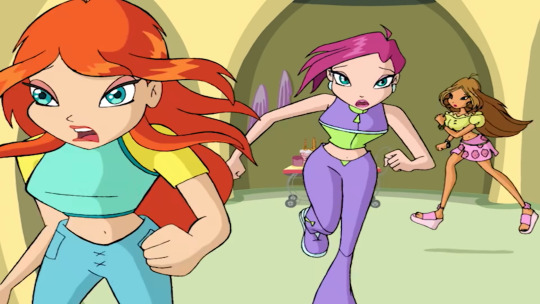

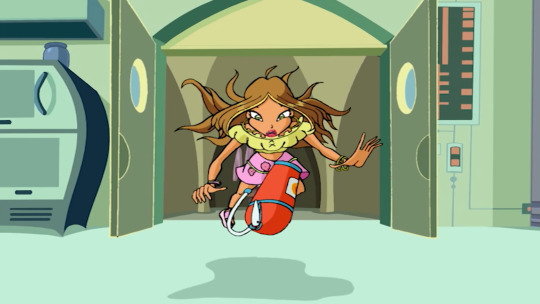
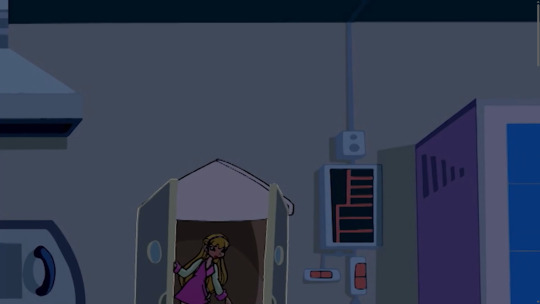
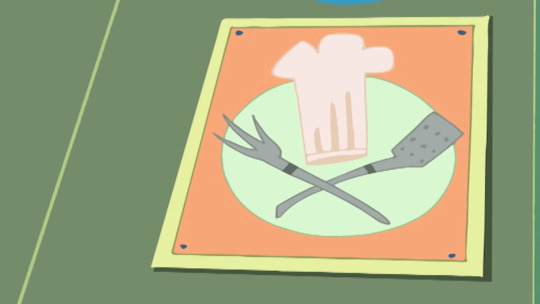
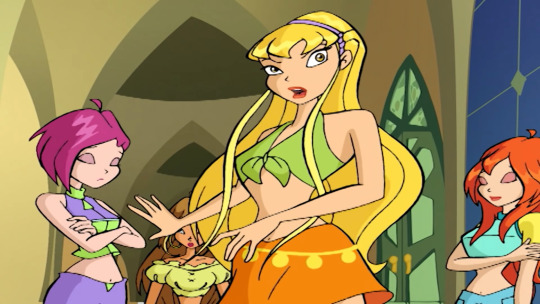
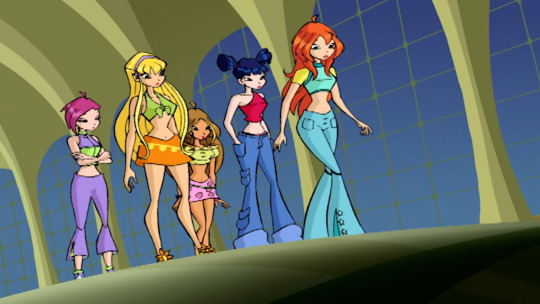
(props to Alfea for having non-magical fire extinguishers for added safety)
Or at least one of the kitchens is in that building, I wouldn't be surprised to find out there are two. Or at least a smaller communal kitchen for the other mirrored building, so the girls don't have to go across campus for a midnight snack.
Further, although the exterior and interiors of the school don't always match up exactly, in several shots of the dining hall, we can see the six bays of tall windows. Now there is a chance they could just be windows from the middle floor, one of the balconied window sets, but the shape and compactness matches much more closely with the tower's rear facing window wall, the one that leads out onto the flat balcony.
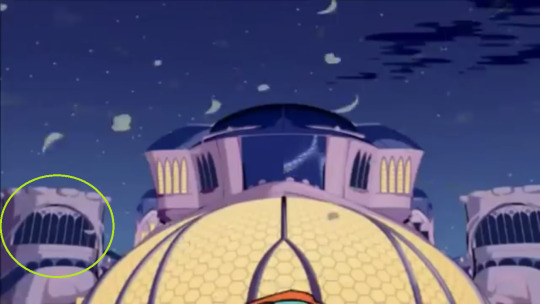
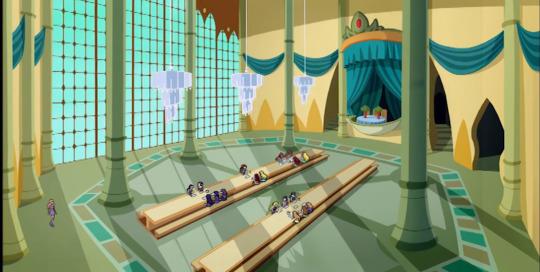
The number of windows/bay divisions don't match up perfectly, but again, internal-external logic consistency isn't 100% at Alfea,
Additionally, in these shots from season two, we can see some smaller windows lining the upper sections of the wall opposite the window wall, which match up loosely with the windows on the rear towers, where they meet the roof of the dorm section.
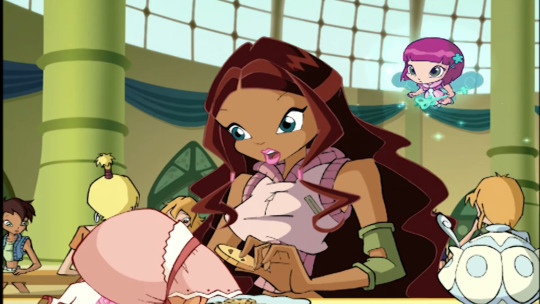

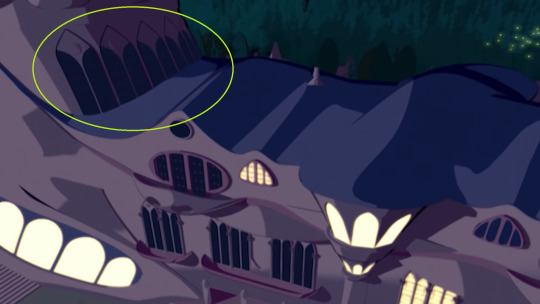
We should also talk about sizes and room dimensions.
Based on the door below the smaller windows, the windows are at least three maybe four meters off the floor. The tables run about 5 meters.

Estimating for girls behind pillars, the most packed side holds 16 students, while the least packed has space for 13.
A quick bit of research into bench tables brought me some numbers.
The longest commercial tables I could find that came with suggested sizing by seat number suggested that for a 10 person table (4 on each long and 1 per end cap, so realistically for out count and 8 person table) would range between 2.2m, 2.6m, or 2.8m depending on how comfy or squished the seating is expected to be. Doubling those numbers to get tables to seat 16 max per side, we end up with tables ranging 4.4m, 5.2m, and 5.6m.
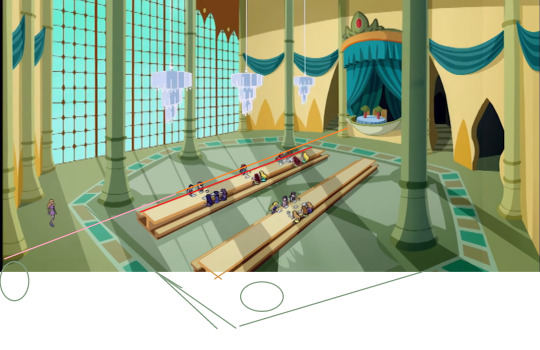

Doing a quick eyeball and stamp measurement, and given that the room isn't perfectly circular, but there is at least one (suspiciously straight) hallway outside it, I'd be okay saying that we're looking at a space with a rough diameter between 9 and 15 meters.
Finally, there's the thing that might be a door opposite the teachers' dais, which I think might match up with the external door on the tower that leads up a protruding staircase to a spiral staircase that leads to the observation platform on the top of the tower.


Or at least an elevator or internal spiral staircase up to the external door, or even a door across a corridor to the external door, depending on how big the overall dining hall really is in relation to the tower it's sitting in.
Why don't I think it leads to the kitchens?
Well, let's look at the kitchen: it looks roughly square, or at least not a whole lot longer one way than the other, so we're looking at a squarer sort of rectangle at most, and with that we can do a few quick calculations based on what's in the kitchen.


First, my research tells me that in a commercial kitchen, like for a restaurant, recommended kitchen size is .5m² per seat. The count of the students at the table (estimated 16+14+14+13=57 plus three teachers) give us around 60 seats, which makes our estimated kitchen around 30m².
(That's a fridge in the left corner as far as I can tell, though I did for a short time assume it was stairs. Gosh darn pattern on the door, fooling me.)
Further, commercial fridges, double ovens and cupboards give me widths of 610cm for a fridge, 60.96-68.58-76.2cm for double ovens, and 1200cm for a cupboard. recommended ventilation distance between ovens is a suggested minimum of 15.24cm, and there are four ovens along one wall with the fridge and the free standing cupboard. Using the largest width for ovens, we're looking at a room of at least 5.62m across.
It's important I note here, that the room isn't actually square, while the main body of it looks that way, there's also a little alcove attached along that wall.
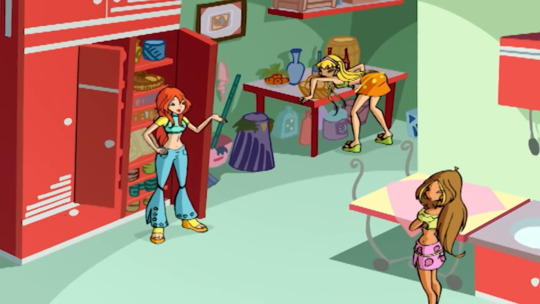
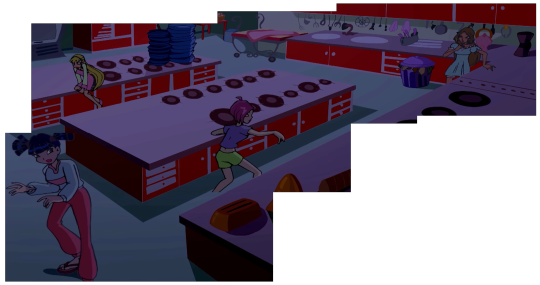
Now there is a bit more space between the ovens than is recommended, enough for Musa to hide between them comfortably, but this gives us a starting base.
Even if the dining hall is 15ms across on the outside, that's still enough room to fit the kitchen in the tower given some of my other calculations which have the width of the mirrored buildings at 24-30m across, which should translate to the width of the flat topped towers.
But again, there's that zoom in, and the fact the girls come in from the side and turn left into the kitchen. I think we're looking at a kitchen position that's a little something like this:

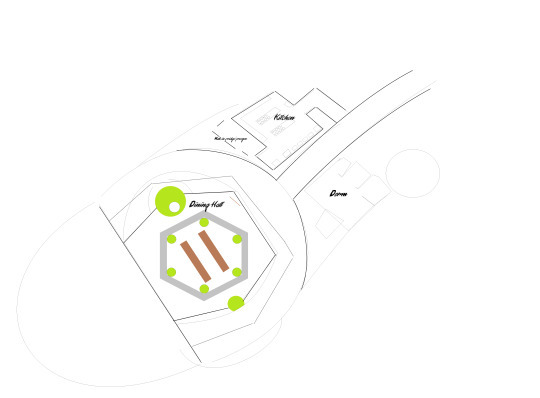
Although I am hoping that despite the lack of any doors in the alcove, there's actually a walk in fridge/freezer behind the back wall, because there's plenty of cooking spaces, but there doesn't seem to be much in the way of food storage outside the free standing fridge in the corner, the pantry by the alcove, and the alcove.
Maybe there's more in the various short cupboards, but at least a portion of those would be for cooking utensils, crockery, cutlery, and I don't see any that are different enough to indicate cold storage vs long-life/shelf.
#winx#winx club#alfea#alfea mapping project#alfea dining hall#alfea kitchen#guesstimate measurements#season 1 reference screenshots#season 2 reference screenshots
81 notes
·
View notes
Text
Ultimately, unless you choose a planet that has an insanely slow rotation or is tidally locked, sooner or later the day will end and night will fall.
Night time is when the monsters get more active. When it’s hard to see. When sunlight can’t be used to kill them. When he’s supposed to be asleep, but if he does sleep he won’t make it to see the sun rise again.
He hates this planet.
But this planet is where the problem lies.
The GSA will have to come here eventually, they have to.
He’s been discharged from the army. He dug somewhere he wasn’t supposed to dig, got too close to exposing some ugly truth. And now, he’s on his own.
But that doesn’t mean he’ll lay down and stop helping. His comrades are still his comrades, even if he isn’t part of the GSA anymore. He can still protect them, leave them information to find, and help them. Besides, lying down isn’t an option even if he ever decided to turn his back on the army entirely. He’s still a star warrior. Demonbeasts designed to hunt and kill star warriors do not care if he’s a part of the army or not.
And they know he’s here.
He starts preparing for the night well before dusk approaches. The first night is always the roughest after the initial night of running for his life, when he has to quickly establish his lines of defence, make a base camp that will protect him.
When he doesn’t know entirely what works yet and what doesn’t.
Sunlight kills these monsters. Great! But what about when it’s dark? What happens then? Can any light kill them or is it specifically just ultraviolet radiation that they cannot stand? They can phase through walls and take a crossbow arrow without so much as flinching. If you stare at them, they stop moving. All great stuff but that doesn’t teach him how to kill these horrid creatures.
He takes a moment to stop and consult his journal, staring at the sketch he did, the ink finally having dried. A round creature covered in bandages, only one eye slipping through the folds. Teeth. There were a lot of teeth hidden in there, and his bandaged up arm proved it. He shivered a bit remembering how the red light from its eye bathed over him when he had his back turned.
Right. Deep breath. In, out, freaking out now is how you don’t survive the night. He’s not freaking out.
He pulls out his warpstar, checks it over. No more cracked than yesterday….Still a little spent from relying on it to run all last night. He remembers well when that crack formed, he had heard it in his head, like some inner part of him was splitting apart. He had felt it in his chest, a pain that wasn’t sharp nor stabbing, but somehow worse and so, so incredibly cold as if a void that sucked up all light and heat had spawned in his body.
He reminds himself that the feeling passed weeks ago.
But it’s all too easy to remember, and he knows well that it’s going to happen again.
Alright, enough messing around contemplating his stability. He’ll be doing it lots he’s sure, but he’ll have to learn to do it when there’s actually moments to spare.
He finishes up with his shelter, it’s about as sturdy as it’s going to get, he estimates he has about two hours of daylight left. Time to make some kind of weapon.
His main weapon is his crossbow, his arrows can be modified to deal with various demonbeasts. The first arrows didn’t work. So, he followed the typical star warrior motto: if your weapon isn’t whacking hard enough, you find out what makes your enemy weak, get yourself a stronger weapon and teach yourself to whack harder.
Supernatural ‘nonsense’ helps too. He remembers a time where he thought all of that was just fairytales and hysteria.
Nope. Ghosts are real. Zombies too (though zombies are actually a lot more social and intelligent than you might think!) Werewolves exist and he’s pretty sure there’s not one but multiple gods. Ironically, demonbeasts aren’t actual demons which is why salt doesn’t work on them, but actual demons are also very much a thing. And maybe this isn’t an actual vampire, it’s definitely a lot like one.
It’s grounds for start on.
He makes it to the following day to update his journal.
So wooden stakes are actual bullshit when it comes to these creatures. Maybe he’s not using the right kind of wood, but it’s about as effective as actual crossbow bolts and getting that close and personal almost ended up with his wing being ripped clean off his body. More tests will have to be conducted, not that he’s particularly interested in getting that close again.
Charms and crosses work about as well as salt, but interestingly enough smudging seems to have… some effect? Possibly repels a creature with evil intentions. Or maybe the demonbeasts just don’t like the smell, he knows that after a while the smell goes from comforting to headache inducing. A reminder that he’s doing this because something is actively trying to kill him.
He tried setting it on fire, following the logic that if sunlight burned it maybe fire would too. No, no by some backwards logic that isn’t how it works, it just makes this absolutely horrendous burning decay smell that he can’t get out of his feathers. Only sunlight kills these things, if only he could somehow trap them and keep them in the sunlight to-
Can he capture them? How did one capture a creature that can phase through walls? He thought about it as he set out into the surrounding area to explore and find rations, the sun burning overhead. His travels took him to an old abandoned settlement, one he recalled running past on his first night to this planet. It looks much less decrepit during the day, interestingly enough if you ignored the dust and the overgrown vegetation, and the complete and utter lack of people and the overhanging sense of stillness, you might not even know it was abandoned. It’s as if, in a trance, all the people got up and left silently, or were all simultaneously vaporized in an instant.
They must’ve left, when it was clear Nightmare had his eyes set on this planet. Evacuated. Here’s hoping, because all the alternatives are simply sad.
When the army comes, they’ll probably find this place and use it as a base camp. For a moment he closes his eyes and pictures tents set up around, the sounds of soldiers doing tasks and drills until the sun goes down and they sit together around fires sharing stories of their battles and home worlds.
They won’t be able to do that with these demonbeasts. If they arrive here unaware of the dangers their first night is going to be sleepless restless carnage. He needs to prevent that.
The star warrior finds himself next to one of the buildings, where a large pot is filled to the brim with rain water. Tiredly, he scoops some of the water and lifts it to his mouth to drink, brown gaze shifting to the symbols lining the vessel. It’s not a language he recognizes off the top of his head, but the symbols are pretty universal. The circle with lines surrounding it is clearly meant to be the sun, another is of energy and another protection.
He sits there for a moment, recalling the word he used to describe the urn like pot.
Vessel.
Cage.
Idea. He had an idea.
#kirby#hoshi no kirby#kirby anime#kirby right back at ya#art#kirby oc#kirby art#kirby of the stars#kirby au#digital artist#kirby wolfbell au#snippet#short story
35 notes
·
View notes
Link
In the vast, dark expanse of the universe, there lies a mystery about the first stars—massive, luminous celestial bodies that lit up the cosmos in its earliest stages. These stars, known as Population III stars, are so far removed from modern astronomy’s reach that their properties remain largely unknown. Scientists have spent decades searching for a way to uncover the details of these ancient, enigmatic stars. Today, a new method is bringing them into focus, using faint signals that were emitted billions of years ago. The 21-Centimeter Signal: A Cosmic Whisper The breakthrough lies in a faint, nearly undetectable radio signal that has persisted through time: the 21-centimeter signal. This signal, emitted by hydrogen atoms shortly after the Big Bang, is a key marker from a time known as the Cosmic Dawn—the moment when the first stars began to form and light up the universe. The 21-centimeter signal is particularly valuable because, unlike visible light or X-rays, it can provide direct insights into the masses, behaviors, and distribution of the first stars. Yet, until recently, astronomers had not fully understood the ways in which this subtle signal could help reveal the early cosmos. How Scientists Are Using the 21-Centimeter Signal An international team of astronomers, led by Professor Anastasia Fialkov at the University of Cambridge’s Institute of Astronomy, has cracked a crucial aspect of this signal. Their work, published in Nature Astronomy, demonstrates that this ancient radio signal is sensitive to the properties of the first stars. Specifically, their research suggests that the signal could be used to estimate the masses of the universe’s earliest stars—Population III stars—whose light we can never directly observe. This insight is significant because it opens a new door to understanding the early universe, which was primarily composed of hydrogen and helium. As stars formed, their radiation influenced the surrounding gas, gradually changing the composition of the universe. By studying how the 21-centimeter signal has been altered by these stars, astronomers can begin to chart the transformation from a dark, uniform mass to the complex and diverse cosmos we observe today. REACH and SKA: Key Projects for Mapping the Universe’s Past The team behind these findings is also involved in two ambitious projects—REACH (Radio Experiment for the Analysis of Cosmic Hydrogen) and the Square Kilometre Array (SKA). REACH, still in its early calibration phase, uses radio antennas to capture the 21-centimeter signal, while the SKA is an even larger array of antennas currently being constructed. The SKA will have the capacity to map vast regions of space and study fluctuations in cosmic radiation, providing an invaluable resource for understanding the earliest epochs of the universe. These projects are essential to the future of radio astronomy. By focusing on statistical patterns of faint signals, REACH and SKA offer a way to study the early universe in unprecedented detail. As Professor Fialkov explains, the research team’s model predicts that both REACH and SKA will allow astronomers to study the distribution, luminosity, and masses of Population III stars. This, in turn, will enable a more comprehensive understanding of the forces that shaped the cosmos at its infancy. The Role of X-ray Binaries in Shaping the 21-Centimeter Signal One of the most interesting aspects of this research is its exploration of how X-ray binaries—pairs of stars where one is a collapsed object like a black hole—impact the 21-centimeter signal. These binaries are thought to have played a significant role in the early universe, particularly by emitting high-energy radiation that affects the surrounding gas and alters the 21-centimeter signal. The research team, led by Professor Fialkov, developed a model that incorporates the effects of X-ray binaries, showing that previous studies may have underestimated their influence. This discovery adds a layer of complexity to our understanding of how the first stars shaped the universe. The combination of radiation from both normal stars and X-ray binaries has a profound impact on the signal, making it an even more powerful tool for mapping the earliest moments in cosmic history. Radio Telescopes: The Future of Cosmic Exploration The 21-centimeter signal’s potential is further amplified by the increasing power of radio telescopes. Unlike optical telescopes that capture detailed images of distant stars and galaxies, radio telescopes like REACH and SKA rely on detecting faint signals to infer the properties of cosmic phenomena. These telescopes won’t provide direct images of individual stars, but they will offer an extraordinary opportunity to study large-scale patterns in the universe’s earliest phases. As Dr. Eloy de Lera Acedo, Principal Investigator of the REACH project, notes, these radio observations are essential for understanding the mass and properties of the first stars. The team’s work is laying the groundwork for future discoveries, with the data gathered from the South African site of the Karoo radio telescope already being analyzed. Enjoyed this article? Subscribe to our free newsletter for engaging stories, exclusive content, and the latest news. For more news like this, visit Dailygalaxy.com.
7 notes
·
View notes
Text
Thoeries and Haedcannons Pt. 26
So new Life Series brings new biomes, new teams and new skins that brings new lore to the participants of the Life Series. With the first episode of Wild Life been aired about a week ago, two new developments regarding two contestant's skin has been made. Specifically Pearl's new transistional skin change and BigB's cross-hybrid development into a creaking-esque skin.
Starting with BigB's skin changes, ever since the 20th of October where he began reposting artworks depicting him as a creaking reminiscence of his basing location in the Creaking Forest, a new skin has been released depicting his change to a Creaker. Changes from his original Life Series skin includes desaturated and greyscaled skin, inclusion of muted greens and oranges and yellow to highlight mainly his eyes and the creaking heart lodged between his right ribcage. Similar to the Creaking, BigB also does have striking similarities to the actual biome with the oranges possibly representing resin and eyeblossom flowers arriving to the biomes in the next drop. It would be fitting because quite literally, his right arm has turned into wood, possibly because of the creaking heart that has mutated his body to acclimate to his new enviornments.
Next, Pearl's new provisional skin that seems to be a transistional period between her Hermticraft Season 8 skin and her 5am Pearl persona. An unusual break in trend as generally she would use her Scarlet Pearl skin during the last few sessions of the Life Series. Well in her twitter post that first leaked her new skin on the 23rd, she was seen with Impulse in his classic Life Series skin that seems to be the west of their base according to rough estimates for the Wild Life map. She and Impulse are also seen with torches so it's a safe estimate that they're lighting the area to prevent other mobs from spawning in the heavily darkened forests near their and BigB's base.
It could be just a temporary change because the most recent wildlife that resulted in the first demise of the server, but that would still leave her with five lives. Far from yellow or even red lives range where 5am Pearl would essentially control Pearl's mentality and sanity.
But reasoning could run deeper than that. Ever since her introduction to the Life Series back in Last Life, Pearl dawns her Hermitcraft Season 8 skin with majority of the colours being subsituted for red and her eyes also gaining red highlights to signify her red-life status. This pattern of wearing her red-life skin was kept throughout every season up to Secret Life but Double Life where certain events occurred.
Specifically the severing of her bond with her soulmate Scott, during the first few sessions resulting in the formation of the Divorce Quartet and the beginning of her torment and rampage as Scarlet Pearl. Her pain further continued from the death of her dog Tilly, and causing others to view her as crazy and demented from her irrational behaviour. Her relationship with the other members of the Divorce Quartet continued to waver until endgame where they all teamed for the benefit of their individual survival. It was until the second icarnation of Tilly was burned by Impulse where Pearl began on a true rampage by slaughtering both Impulse/Bdubs and Cleo/Martyn. Eventually being crowned victorious after Scott sacrificed himself.
This carries into Wild Life where Pearl allied with the Divorce Quartet but with the abscence of Martyn and the addition of Impulse. So perhaps her transitional skin could be Pearl's reminder of her troublesome past with her quartet. But as a transitional period, her Scarlet phases only remain as a irksome reminder about what she could became isolated again. She's now surrounded with healthier support network with a new ancestor of Tilly being around as Billy and as well others like her allies who she reconciled with and Impulse.
These support networks could halt the reappearance of early 5am Pearl through the supportive and healthy relationships surrounding her.
_____
AHH i was stressing to this out before episode 2
Links used:
/ https://namemc.com/skin/fb4a13c31f6d863e - Bigb's skin
/ https://namemc.com/minecraft-skins/profile/PearlescentMoon.1?page=1 - Pearl's skins
/ https://www.reddit.com/r/ThirdLifeSMP/comments/1gapkqi/everything_we_know_about_ep_2_so_far/ - grouped post about the episode 2 leaks
#burd!theories&headcannons#life series#the life series#wild life#wild life smp#trafficblr#traffic smp#bigbstatz#the creaking#creaking bigb#pearlescentmoon#scarlet pearl#5am pearl#tilly#divorce quartet#impuslesv#scott smajor#zombie cleo#martyn inthelittlewood#martyn itlw
24 notes
·
View notes
Text
Also preserved in our archive
By Andrew Joseph Pegoda, Ph.D.
Unlike its SARS-CoV-1 predecessor a decade prior, SARS-CoV-2—frequently called COVID-19 to lessen alarm—has been an on-going, global crisis starting soon after its emergence in December 2019. The tenth wave of this Level 3 biohazard is starting and the injustices continue.
Official global deaths reported by governments total 7 million. Data scientists, demographers, and economists closely eyeing excess deaths have staggering estimates of actual COVID-19 loses: 20 million by the end of 2021, 30 million by the end of 2023, and currently almost 40 million.
Deaths from this novel, highly contagious virus are sometimes unavoidable. Yet, the vast majority of these seldom-acknowledged deaths are stupid deaths, stupid deaths because they were preventable deaths.
Death tolls from COVID-19 in the United States specifically would be lower had the CDC not given into pressure from Delta Air Lines in 2021 to decrease isolation periods. Death tolls would be lower if states en masse had not rushed to abandon mask requirements in 2021 and 2022. Death tolls would be lower if Hollywood’s stories meaningfully acknowledged COVID-19. Death tolls would be lower if the public narrative had been other than “vax and relax.” Death tolls would be lower if schools and businesses devoted meaningful efforts to improving and monitoring air filtration, especially in elevators. And the recent “back to the office” push will only increase deaths.
Beyond death tolls, I am concerned about what I am naming “stupid (re)infections.”
The typical person in the United States is being reinfected yearly, and the average person has now been infected with COVID-19 more than 3.5 times. And between 20% and 50% of infections are asymptomatic (during the acute phase!).
Repeated infections are unnecessary and avoidable, if mandatory masking in public places had remained and been completely normalized (of course, with appropriate exceptions for those with disabilities that prevent wearing a mask). Hospitals should have never dropped masking requirements, certainly not cancer centers. KN95 and N95 masks are highly effective and easy to wear—a practice that could only increase utility with the corresponding decreased sickness and death. People learned to wash their hands with soap; they can learn to wear a mask.
And this leads me to what I am naming “stupid suffering.”
COVID-19 is not the flu or a cold. Every infection substantially affects the body—including possible cognitive decline and impacts on the heart, T cells, the intestines, and the overall immune system—prompting a growing number of researchers to assert that COVID-19 triggers a new illness that parallels AIDS. Impacts further down the road remain unknown. Still, many people antidotally report having at least some lingering symptoms after their initial symptomatic infection. Specifically, Long COVID, which can be debilitating, impacts tens of millions in the United States, including 6 million children, and currently has no cure. Every infection substantially increases the risk of developing Long COVID. And this stupid suffering disproportionally impacts and further weathering minoritized individuals.
Stupid (re)infections. Stupid suffering. Stupid deaths. We must do better and not allow brute luck to dominate while awaiting treatments and better vaccines.
If missions to save lives and protect best interests are sincere, bioethicists have a profound opportunity, even a categorical imperative, to help lead the way toward a COVID-19 safer future and opportunities for reenvisioned justice, for Aristotle’s the good life.
COVID-19 uniquely shows the heteronomous nature of twenty-first-century life and what little weight negative rights hold as people—especially those already disabled like me—are forced into spaces that ignore the threats.
Andrew Joseph Pegoda, Ph.D., M.A., M.A. (@ajp_PhD), is a Lecturer of Women’s, Gender, and Sexuality Studies at the University of Houston and a Bioethics and Health Policy graduate student at Loyola University Chicago.
#mask up#covid#pandemic#public health#wear a mask#covid 19#wear a respirator#still coviding#coronavirus#sars cov 2
88 notes
·
View notes
Text
by Daniel Greenfield
The Associated Press recently made headlines by falsely claiming that the Israeli campaign against Hamas “sits among the deadliest and most destructive in recent history” and was even worse than “the Allied bombing of Germany in World War II”.
The Washington Post argued that “Israel has waged one of this century’s most destructive wars in Gaza” while The Wall Street Journal contended that it was “generating destruction comparable in scale to the most devastating urban warfare in the modern record.”
That’s all the more impressive since even accepting the Hamas casualty figures (tainted and inflated numbers in which there are no terrorists, only civilians, and fighting age men are really children) as the media does, this is still probably one of the least violent conflicts in the region.
In 2016, the Washington Post described the Syrian Civil War, with a possible 250,000 deaths, as “the most destructive conflict in the region”. In 2020, the UN had called the Yemeni Civil War, with 150,000 deaths, “the most destructive conflict since the end of the Cold War”.
And then there’s the current phase of the war in Sudan (which the media is currently uninterested in) in which 15,000 people have been killed over the course of last year, as part of a larger conflict that may have claimed as many as 2 million lives.
The Tigray War in Ethiopia over the last three years (which you may have missed because the media chose not to hysterically cover every single bomb dropped and protesters stayed home knitting instead of blocking traffic) may have cost the lives of between 80,000 to 600,000 people.
(El Pais, Spain’s newspaper, which did report on Ethiopia’s civil war, described it as “the deadliest of the 21st century” and then had to pivot to argue later that Israel was worse in, “25,000 deaths in Gaza: Why the destruction of this war exceeds that of other major conflicts”.)
In reality, every significant war and civil war in the region had a much higher death toll than the Hamas war: including the Iraq-Iran War with an estimated 500,000 to 2 million deaths. And in nearby Africa, the Congo War has been blamed for 6 million deaths since 1996.
How does the media justify arguing that 25,000 is more than 2 million?
There are plenty of statistical gimmicks available to anyone who wants to argue that 2 + 2 is really 5. Media “analyses” that claim that Israel’s campaign against Hamas is the deadliest and most destructive, and might even be worse than WWII, adjust their claims accordingly.
As the author of every dubious research study knows, to get the results you want, you manipulate your parameters. Media analyses selectively compare Israel’s campaign to battles, rather than wars, they narrowly focus on very specific timetables, they try to estimate per capita rather than gross figures. But drawing a circle around a particular area and going per capita works both ways. The Hamas attack of Oct 7 killed 10% of the population of Kibbutz Be’eri making it far worse per capita than anything in Israel’s response to those atrocities.
But statistical fudging is all in where the line is drawn to achieve a particular agenda.
For example, the New York Times declares that, “Gaza Deaths Surpass Any Arab Loss in Wars With Israel in Past 40 Years”. Of course the last major Arab-Israeli war took place 50 years ago.
The 40 year figure is based on the Lebanon War, but the actual numbers for that war vary wildly from the thousands according to Israel, 10,000 according to the CIA, 18,000 according to Lebanon and 30,000 according to Arafat and the PLO.
While the media at the time emphasized the highest estimates, in order to criticize the Israeli campaign against the PLO, they now use lower estimates to attack the Gaza campaign.
63 notes
·
View notes